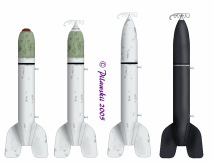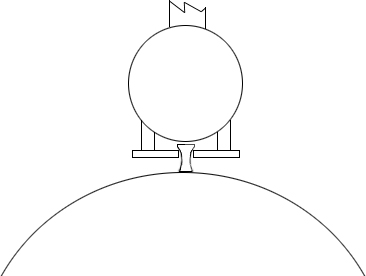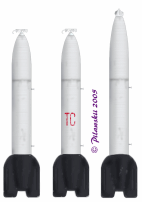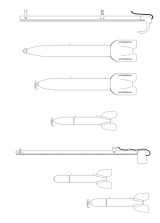
The RS Rocket Family
Certainly one of the most recognizable types of external munition in use in the VVS was the RS type rocket. The designation RS merely stood for roketniy snaryad , or 'rocket projectile', and was followed by a number describing the diameter of the missile (i.e. RS-82 = 82 mm diameter). During the GPW, an 82 mm version and a 132 mm version were both employed.
The RS-82 was developed during 1936-37 by Klemenov and Langemak, this being deployed in action for the first time in 1939. The missile body was made from low-grade steel tubing, this in two pieces with a threaded joint. The forward section contained the explosive warhead, which initially was 0.52 kg of amotol A82/20 (and later A90/10 variety). Four sheet-metal fins were spot-welded to the aft end of the body for flight stability, and the nose contained an opening for a contact type fuse (usually of the simple AB or ABM variety). The entire unit was 325 mm in length and weighed 6.8 kg, with a flight velocity of 350 m/sec.

From left, the early RS-82 without a fuse attached. It was common to mount and prepare the rockets onto the aircraft first, and then add the fuses before take-off. When the fuse was absent, a small reddish-brown bakelite cover was installed (shown). Next, the early RS-82 fitted with the bomb-type ABM fuse. It appears that the RS-82 was usually painted, noting the appearance presumably in AII Aluminum lacquer. The forward nose section was often painted in Army 4B0 Green, although certainly not always so.
Next to this we have the later RS-82, this showing a revised forward shape and a new RS-specific type fuse (designation as yet unknown). The later model RS-82 retained the original aft section, but the warhead was now revised both internally and externally. The external shape was more pointed, whilst the 0.50 kg amotol warhead was now shaped into a HEAT type cone. Many sources have written about this model as a "BRS-82" (B = bronirovaniy, or 'armour'), a specific anti-armour model, but to date no official documentation has been located which mentions such a designation. However, examples of the older pattern RS-82 are evident in the photographic record as late as 1944; it may well be that the later model was used in this capacity, and older ones for non-armoured targets, and that perhaps it was a common practice in field units to refer to them in this manner. Investigation will continue.
Be that as it may, the new pattern RS-82 does not seem to show a painted nose. The body is still usually seen in AII (Al), but some examples are known with a very dark colouration. There have been many suggestions as to the exact colour, but all of the available photographs suggest Black (perhaps AEh-11 or AMT-6) as the most likely choice.
All of these rockets were carried originally on a specific mounting known as the RO82. In fact, some aircraft programmes (such as the MiG-3) did did develop their own unique mounting arrangement and hardware, but the standard unit was the RO82. This unit was essentially rounded in form, with two flat steel rails welded below. The device was fitted to the wing undersurface via an adjustable bolt fore, and a simple brace aft. Two rings for the electrical wire, and a plate where this entered the wing, were welded to the aft part of the unit, which terminated in a black 'box-like' structure. It is hard to determine if this unit was of metal or plastic construction, and the lack of apparent wear to any known example is intriguing. In either case, this unit had a hole for the electrical wire and contact (used to fire the motor). The RO rail was almost always painted with the undersurface colour used on the aircraft, thus either AII Blue or AMT-7, but unpanted examples are known. Needless to say, most examples show considerable wear.

The RS-82 was attached to the RO82 rail by means of small pins mounted on the missile. These pins are exceedingly difficult to draw in scale with the rocket, so I have left them off the scale line drawings (they can be seen in the colour profiles). However, their shape and their operation can be seen in the front enlarged view of the RO82 rail. The pins fitted between the bottom rails of the unit, and simply slid aft/forward when the rocket was loaded or fired. The fit was fairly snug, and a wire retained the windmill type fuse; together these two were obviously sufficient to obviate the need for additional bracing when loaded. These pins, incidently, were installed into threaded holes in the rocket's casing.

During 1939, work began on a new version of the RS rocket, this more powerful and with a larger diameter. The new RS-132 featured many improvements. The casing was now of high-grade steel, and indeed the nose section was a semi-armour-pentrating format (thickened internal shape and walls). The body appears to have been a one-piece unit, but with the forward section welded in place at the time of manufacture. There is always some kind of 'linear' feature present in this location, but no actual panel line is ever discernible, even when inspecting the unit by eye. The specialized RS type fuse was retained on the standard models, and the warhead was now 1.39 kg of amotol (A90/50). The rocket motor was also improved, and the initial firing velocity was raised to 385 m/sec. Four pieces of sheet metal were spot-welded to the aft section, then the fin portions stamped together to make a tail. The result was a V-shaped item at the fin leading edge where the two pieces joined, and often one can see a slight mis-alignment at the aft end of the fins resulting from the stamping process.
The body of the RS-132 appears not to have been painted at all. The aft fin section was painted with Black, usually AMT-6 (although AEh-11 might be seen, as well). Some versions of the RS-132 seem to have been marked with the stencil "TS", in red. At this time, the meaning of this marking is not understood, nor is the reason it appears only sporadically (but only on the standard shape RS-132).
The original configuration RS-132 rocket appeared in 1942. This was followed near the end of the year by another model which was externally similar. This version was designated ROS-132 (O = oskolochniy, or 'fragmentation'), and as the name implies, the warhead was revised. The ROS type had a thin walled nose section with 1.66 kg of amotol explosive, this augmented by a 'sheath' of scourged low-grade steel which turned into 0.4 kg of shrapnel when the charge detonated. The ROS, therefore, obviously possessed no penetration capability and was designed only for 'soft-skinned' targets. To date, no external differences have been identified between the RS and ROS model.
This version was followed during 1943 by the special anti-armour BRS-132 rocket. The BRS-132 was in fact longer than the standard models, and carried a new and distinctive fuse. The entire nose end was an armoured cone-shaped unit with a 1.15 kg HEAT shaped-charged explosive. The armour penetration capabilities of this unit were extremely formidable, and even the Tiger tank could be destroyed by a well-placed hit. The rocket had almost no collateral explosive effect, and it was essentially useless for any task besides armour destruction (albeit, the VMF used this version to attack German naval ships successfully). The BRS model was finished identically to the earlier RS-132 types.

The larger size of the new rocket required a revised mounting rail. The resulting RO132 unit was simplified in comparison to the original RO82, but of similar length and general design. The tube itself was a square section box, this again with two flat rails welded below. It accepted the same pins as before, with the same function, and indeed the RO132 could accomdate either the RS-82 or RS-132 family of rockets, in addition to other stores (i.e. the BETAB rocket-bomb). A simple hanger was mounted forward, while a threaded bolt aft provided a small degree of adjustability. The aft section was a steel hook which not only secured the exhaust opening of the rocket, but also contained the wire lead from the aircraft.

A scale set of line drawings follows. These are approximately to 1:11 scale. The drawing is large, and has been formatted in 600 dpi, suitable for printing.
